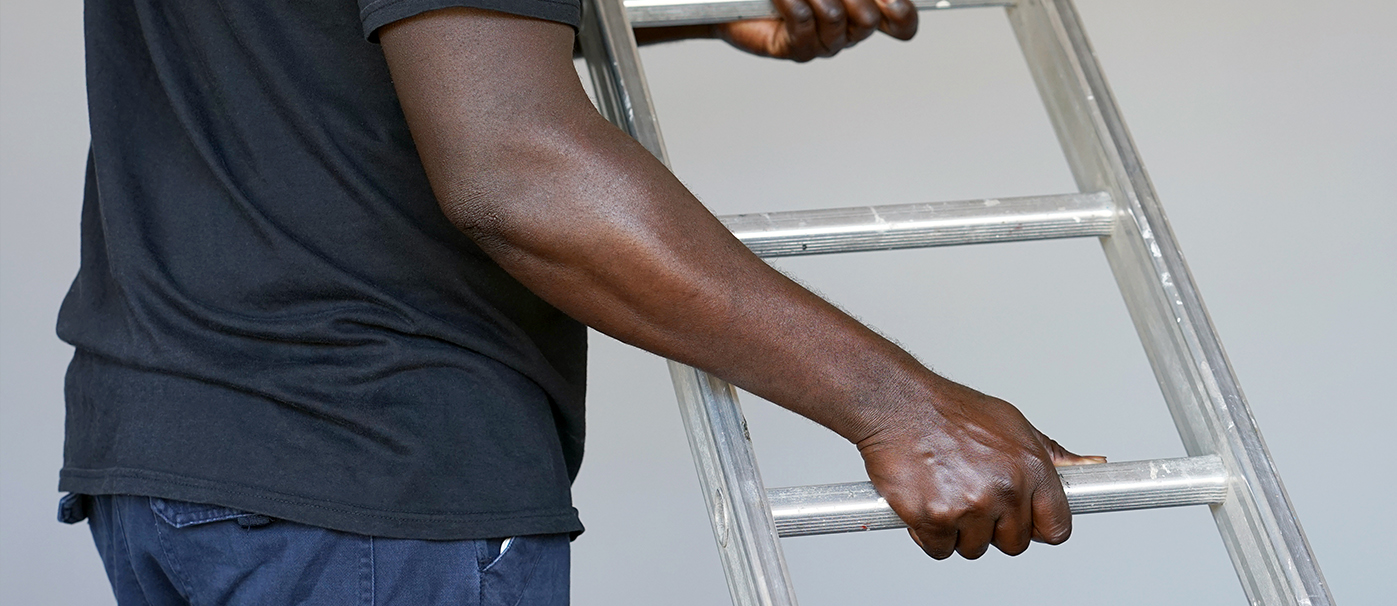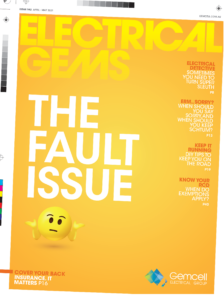Out Now
The AI Issue
Current Issue
The AI Issue
OCT - NOV 2025

When you want to reach great heights, a decent ladder is essential. Here’s what you need to know.
A ladder, for those who need reminding, is a vertical set of steps that take you where you need to go when working at heights.
There are many types of ladder, but they fall into two general categories: flexible ladders, eg rope ladders, which you won’t often see on a building site, and rigid ladders, made of metal, timber or fibreglass. Rigid ladders are either self-supporting (step ladder) or can be leaned against a wall. As an electrician you might well come across roof ladders, platform ladders, sectional ladders, retractable ladders, extension ladders, hook ladders and many more. But it wasn’t always this complicated.
The first known depiction of a ladder is a 10,000-year-old rock painting in Spain’s Spider Caves. The picture shows two humans climbing a ladder to harvest honey from a beehive. By the 15th century, rope and rough wooden ladders begin to appear in European artworks. In the 1860s, inventor John H Basely came up with the modern-day stepladder when he put hinges on an ordinary ladder so it could be folded away. (He also made ladders with flat steps rather than round rungs.)
Hot on his heels, American Henry Quakenbush patented the first extension or telescopic ladder in 1867. By the 1930s the ladder biz was really taking off, with aluminium ladders making their debut, and ladder feet or stabilisers becoming available – a standard safety feature in almost all ladders today.
For too long, the humble ladder has lain low when it comes to tools. They’re cumbersome, they’re not that exciting to use and if you’re a superstitious type, walking underneath one is supposed to bring bad luck. But is that reputation deserved? Whether soccer, AFL or NRL is the game, arguably the world’s most important ladder of all relates to your team’s spot on this ladder come the end of the season. Check out some of the world’s other vital, impressive and unusual ladders.
These wooden bad boys weren’t for the faint-hearted. Putucusi is the most challenging climb up to view the world heritage listed ruins of Peru’s Machu Picchu. In days gone by the climb consisted of several eye-wateringly steep wooden ladders — one more than 30 metres, clinging to the mountain at an angle of 70 degrees. A few years ago floods destroyed some of the ladders in parts and they were removed. You now need to use a rope and a toe hold. Bring back the ladders!
Not to be confused with the 1990 film starring Tim Robbins, the actual Jacob’s Ladder is a biblical term referring to the steps from earth up to heaven. It’s also the name of the road to the summit of Ben Lomond Mountain in the Launceston regions of Tasmania. Ben Lomond Mountain peaks at 1452 metres above sea level, and the road up features a series of sharp hairpin turns. Drive carefully.
This small cedar wood ladder was placed outside the window of Jerusalem’s iconic Church of the Holy Sepulchre some time mid-way through the 18th century. There it’s remained ever since, under strict orders that none of the six Christian sects who oversee the church are allowed to alter the property about without the express permission of each other. This unassuming ladder has achieved such cultural significance, tourists from all over the world flock to view it, and fired-up monks have even punched on over who’s in charge of it.
According to the Guinness Book of World Records, the longest ladder in the world was built by the Handwerks Museum in Austria in 2005. It’s made of wood, has 120 rungs and is a vertigo-inducing 41.16m high.
Keep up to date with our latest news and competitions by subscribing to our regular newsletter.

Issue 183
OCT - NOV 2024

Issue 182
AUG - SEPT 2024

Issue 181
JUN - JUL 2024

Issue 180
APR - MAY 2024

Issue 179
FEB - MARCH 2024

Issue 178
DEC 2023 - JAN 2024

Issue 177
OCT - NOV 2023

Issue 176
AUG - SEPT 2023

Issue 175
JUN - JUL 2023

Issue 174
APR - MAY 2023

Issue 173
FEB - MAR 2023

Issue 172
DEC 2022 - JAN 2023

Issue 171
OCT - NOV 2022

Issue 170
AUG - SEPT 2022

Issue 169
JUN - JUL 2022

Issue 168
APR - MAY 2022

Issue 167
FEB - MAR 2022

Issue 166
DEC 2021 - JAN 2022

Issue 165
OCT - NOV 2021

Issue 164
AUG - SEPT 2021

Issue 163
JUN - JUL 2021

Issue 162
APR - MAY 2021

Issue 161
FEB - MAR 2021

Issue 160
DEC 2020 - JAN 2021

Issue 159
OCT - NOV 2020

Issue 158
AUG - SEPT 2020

Issue 157
JUN - JUL 2022

Issue 156
APR - MAY 2020

Issue 155
FEB - MAR 2020

Issue 154
DEC 2019 - JAN 2020

Issue 153
OCT - NOV 2019

Issue 152
AUG - SEPT 2019

Issue 151
JUN - JUL 2019

Issue 150
APR - MAY 2019

Issue 149
FEB - MAR 2019

Issue 148
DEC 2018 - JAN 2019

Issue 147
OCT - NOV 2018

Issue 146
AUG - SEPT 2018

Issue 145
JUN - JUL 2018

Issue 144
APR - MAY 2018

Issue 143
FEB - MAR 2018

Issue 142
DEC 2016 - JAN 2017

Issue 141
OCT- NOV 2017

Issue 140
AUG - SEPT 2017

Issue 139
JUN - JUL 2017

Issue 138
APR - MAY 2017

Issue 137
FEB - MAR 2017

Issue 136
DEC 2016 - JAN 2017

Issue 135
OCT - NOV 2017

Issue 134
AUG - SEPT 2016

Issue 133
JUN - JUL 2016

Issue 132
APR - MAY 2016

Issue 131
FEB - MAR 2016

Issue 130
DEC 2015 - JAN 2016

Issue 129
OCT - NOV 2015

Issue 128
AUG - SEPT 2015

Issue 127
JUN - JUL 2015

Issue 125
APR - MAY 2015

Issue 125
FEB - MAR 2015

Issue 124
DEC 2014 - JAN 2015

Issue 123
OCT - NOV 2014

Issue 122
AUG - SEPT 2014

Issue 121
JUN - JUL 2014

Issue 120
APR - MAY 2014

Issue 119
FEB - MAR 2014

Issue 118
DEC 2013 - JAN 2014

Issue 117
OCT - NOV 2013

Issue 116
AUG - SEPT 2013

Comments (0)
Write a Comment